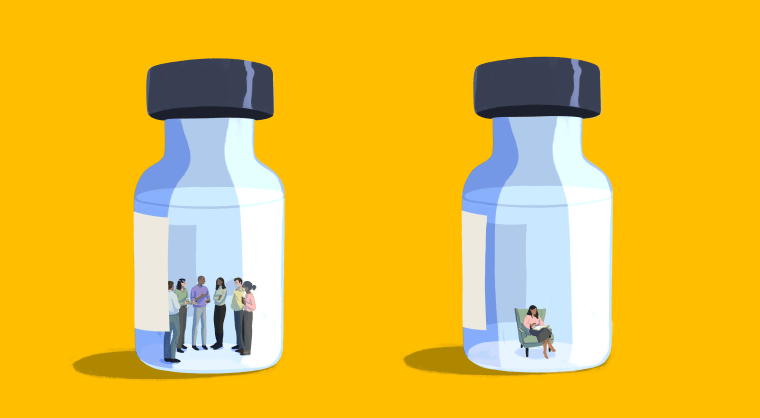Nearly two years into a global pandemic that has taken the lives of more than 920,000 people in the U.S., the masks are finally coming off.
People can do pretty much everything they were doing pre-Covid — and they can do it maskless.
This month, four blue states (New Jersey, Connecticut, Oregon and Delaware) announced an end to indoor mask mandates, including in schools. In New York, Gov. Kathy Hochul is still deciding whether she’ll lift the mandate in schools but has removed it everywhere else. While Covid-19 and its attendant variants have made it virtually impossible to declare an end to this public health crisis, the latest news suggests we have reached the point in the fight against Covid where Americans increasingly get to choose their own path.
Over the past 23 months, the word “choice” has been wielded mostly by anti-vaccine advocates. They have repeatedly declared that their choice whether to wear a mask or their decision whether to get a vaccination should take precedence over the health of those around them.
But now it is the vaccinated people who get to choose. After a terrifying spike in cases in early to mid-January, the omicron surge is in dramatic decline. In just over four weeks, the number of Covid cases has fallen by close to 80 percent. Already, in most parts of America, life has largely returned to normal. Kids are in school, restaurants and bars are open, cultural events are a daily occurrence. While office life has yet to approach pre-pandemic levels, that is as much a product of people’s changing relationship with work as it is an actual consequence of Covid.
With public health restrictions increasingly being lifted — or in many states, simply nonexistent — people can do pretty much everything they were doing pre-Covid, and they can do it maskless.
That doesn’t mean America has moved past the pandemic. Covid continues to kill around 2,500 people every day. Millions of unvaccinated Americans remain at risk, which means tens, if not hundreds, of thousands more people will likely die needlessly from a preventable illness. But considering that vaccines have been readily available for up to 10 months, it’s not clear what else can be done to convince those who seemingly don’t want to be convinced. About a quarter of Americans have chosen the freedom to remain unprotected over the allegedly unreasonable suggestion that they shield themselves from a deadly virus.
Thankfully, the vast majority of Americans have made a different choice.
The fact is, if you’re vaccinated and boosted, your chances of getting seriously ill from Covid are incredibly slim. Your chances of dying are infinitesimally small. For those of us who are not worried about getting sick and feel that the risk of Covid is worth the return to a normal civic and social life, the pandemic has reached a manageable point. We can balance the risks of getting Covid with the desire to return our lives to some semblance of pre-pandemic normalcy. Already that has been happening, and with the further lifting of public health restrictions, it will only pick up steam. And make no mistake, it is the miraculous Covid vaccines that have made this possible.
Considering that vaccines have been available for up to 10 months, it’s not clear what else can be done to convince those who don’t want to be convinced.
If you remain concerned about Covid — or have a co-morbidity or are immunocompromised — you can choose to continue avoiding big crowds and to continue keeping your mask on. The same goes for parents with children under 5. Though the data shows that kids are at a lesser risk, it’s hardly surprising that some parents would want to be extra cautious. Even for all the constant demands to “open everything” (though most everything is already open) there are going to be some Americans who are wary of letting their guard down. It’s hard to blame them. After all, in the spring, many thought the pandemic was nearing an end; then came delta. After that wave — and a decline in cases and deaths — it seemed that maybe normalcy was around the corner; then came omicron. The pandemic has been a frustrating process of one step forward and two steps back.
But what’s different now is, for perhaps the first time since the pandemic began, we can trod our own path.
Americans are being given a clear option to make their own decisions about their health and risk tolerance. These are the kinds of choices that are made practically every day — and in ways we don’t often recognize. When we get in a car on a snowy, icy day or bike on a crowded city street or when we dole out new freedoms and responsibilities to our kids, whether it’s allowing them to walk home from school or giving them access to social media platforms on their phone, we engage in a perennial balancing act. Covid will be no different.
Covid is not going away, and it will be a part of our lives for the foreseeable future. How we deal with that reality will define the next stage of Covid. While it doesn’t mean the pandemic is over, it does mean we’re far closer to its end than its beginning.

